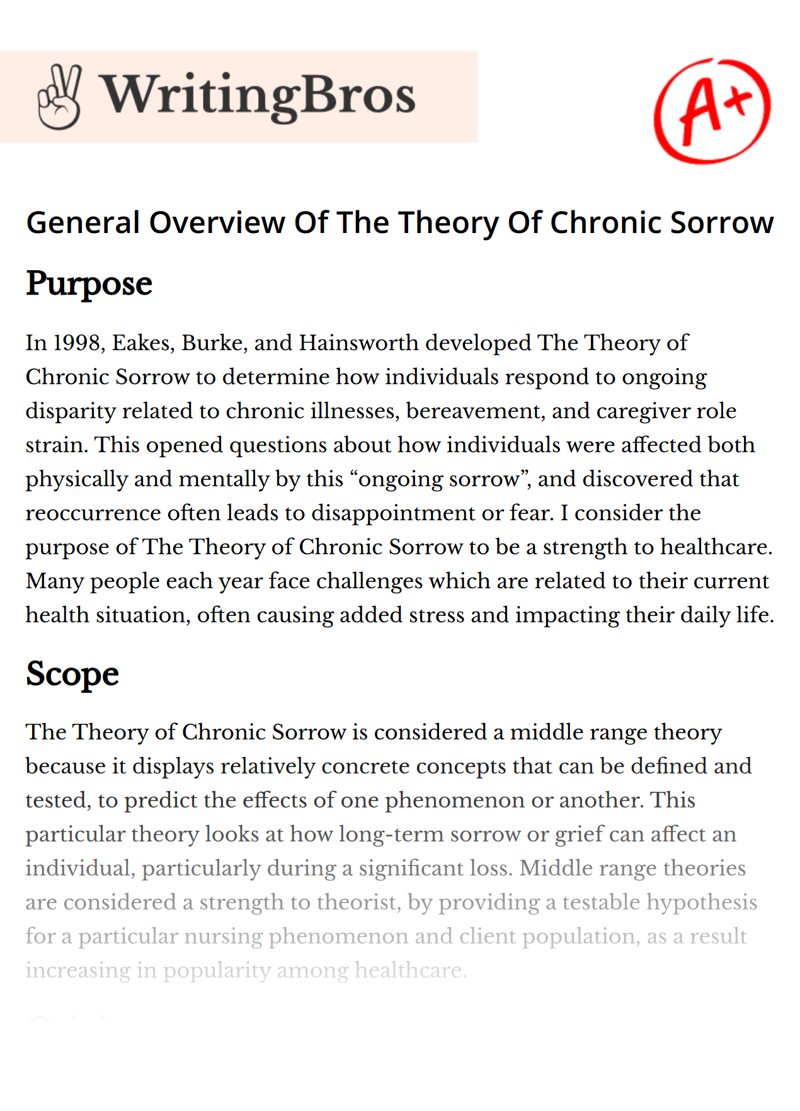General Overview Of The Theory Of Chronic Sorrow

Table of contents
Purpose
In 1998, Eakes, Burke, and Hainsworth developed The Theory of Chronic Sorrow to determine how individuals respond to ongoing disparity related to chronic illnesses, bereavement, and caregiver role strain. This opened questions about how individuals were affected both physically and mentally by this “ongoing sorrow”, and discovered that reoccurrence often leads to disappointment or fear. I consider the purpose of The Theory of Chronic Sorrow to be a strength to healthcare. Many people each year face challenges which are related to their current health situation, often causing added stress and impacting their daily life.
Scope
The Theory of Chronic Sorrow is considered a middle range theory because it displays relatively concrete concepts that can be defined and tested, to predict the effects of one phenomenon or another. This particular theory looks at how long-term sorrow or grief can affect an individual, particularly during a significant loss. Middle range theories are considered a strength to theorist, by providing a testable hypothesis for a particular nursing phenomenon and client population, as a result increasing in popularity among healthcare.
Origins
The Theory of Chronic Sorrow was first introduced in the 1960’s to describe how parents of children with mental disabilities coped and experienced grief. Later the theory would evolve from the effects on parents with children with mental and physical disabilities to the effects of experiencing a “significant loss”. The concept was finalized in 1998 by Eakes et al. by a series of studies, reviews, and research. I believe narrowing the theory to how an individual’s response to a significant loss and chronic sorrow allows us to apply this theory to nursing practice and provide education and assistance to those suffering.
Major Concepts
Three concepts help define The Theory of Chronic Sorrow including; the experience of a significant loss, disparity by determining how an individual’s reality is different from their ideas, and trigger events. Significant loss can range from an ongoing event such as the birth of a disabled child or being diagnosed with a chronic illness, or maybe a circumscribed loss, like the death of a loved one. Disparity is an unresolved grief from a loss and causes a gap between the actual relationship and a desired one. When individuals experience a loss, it’s often difficult for them to come to the realization about the incident, which in turn can prolong the grief process. Other factors that contribute to chronic sorrow are “triggering event”, these can be anything that reminds an individual about the loss and exacerbates disparity. According to Eakes, 2017, p.95, the “lack of closure associated with ongoing disparity sets the stage for chronic sorrow, with the loss experienced in bits and pieces over time”.
The concepts mentioned earlier should be considered strengths to The Theory of Chronic Sorrow, by providing questions to ask and gathering information, we can learn more about our patients and families to determine individualized care plans to help with the coping process.
Major Theoretical Propositions
Theoretical propositions to consider with The Chronic Sorrow Theory are: internal and external coping management. Internal coping management is defined by how an individual can adjust and respond to a significant loss. External coping management is when an individual seeks the support or resources from a professional, such as a physician or nurse to help assist with the coping process. If an individual can cope successfully, this helps to increase comfort and peace, and prolong the amount of time between grief episodes. If not successful, this could lead to increased discomfort or fear and narrow the amount of time between grief episodes.
Strengths of theoretical propositions are allowing health care workers to determine how individuals are managing their grief, and decide if further assistance is needed. This allows nurses to ask questions and provide comfort and resources to better assist these individuals and provide closure, to end chronic sorrow.
Major Assumptions
Many assumptions play an essential role in The Chronic Sorrow Theory including; health, environment, and individual perception. How individuals perceive a significant loss or chronic illness is unique based on their culture, religion, gender, or social background. An environment can determine how individuals cope with a significant loss such as; family support, careers, interests/hobbies, etc. One can assume that an individual that is surrounded by a strong support system or is involved in their career or hobbies are more likely to cope with a significant loss in a more positive way. Current health status can determine an individual’s response to a loss. If a person is struggling with a mental/physical disability, you might think it will impair their coping mechanisms, leading to ongoing sorrow versus an individual that is mentally and physically healthy.
Many strengths can be found within the assumptions category, it’s essential within our profession to look at the individual as a whole and consider what resources they already have, and what else can be implemented to encourage positive coping.
Context for Use
Chronic sorrow is a typical response by individuals to a significant loss or the diagnoses of a chronic illness. It’s important to realize that everyone copes uniquely and that it is considered a “normal process”. As nurses, we need to provide support to individuals, patients, and families to help them recognize warning signs and educate them on positive ways of coping, by listening, providing resources, and reassurance. If we can provide successful ways of coping, we can help decrease discomfort and fear in these individuals, and allow them to return to a healthier state in life.
Cite this Essay
To export a reference to this article please select a referencing style below

